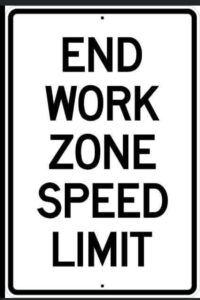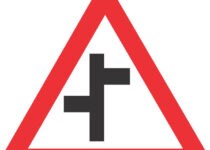Zone End Signs | What You Should Know
Understanding Zone End Signs
Zone End Signs are not just markers that say “something is over.” They are transition points in the language of the road — signals that tell drivers they are leaving one set of behavioral expectations and entering another.
Every road network is divided into zones of regulation — areas governed by a particular rule: speed limits, parking restrictions, emission controls, or safety measures like school zones.
Within those zones, the rule is constant; beyond them, it changes. The Zone End Sign is the boundary marker that defines where this shift occurs.
Unlike ordinary signs that impose a rule (“Speed Limit 30,” “No Parking”), a Zone End Sign performs a subtler but equally vital job: it removes a condition. It says, in effect, “The specific restriction you were following no longer applies — but remain alert, because new conditions might.”
In design terms, these signs are deliberately minimal. They often mirror the start-of-zone sign but with a diagonal black line or the word “End” added.
This simplicity reflects a universal design philosophy: a clean signal for a clean transition. Drivers can process it instantly, even at a glance.
Philosophically, Zone End Signs represent the idea that order is defined not only by rules but by their limits.
A zone without an end sign feels incomplete — because every controlled space must open back into freedom, and every regulation needs a clear boundary to make sense.
So, while they might seem like minor roadside details, Zone End Signs are part of the invisible grammar of the road — punctuation marks that help traffic “speak” clearly, guiding drivers through the constant rhythm of regulation and release.
Types Of Zone End Signs

1. Speed Limit Zone End Sign
The Speed Limit Zone End sign indicates the end of a special speed limit zone — meaning the restricted speed (for example, 30 km/h) no longer applies beyond that point. After this sign, the general speed limit or any newly posted limit takes effect.
2. No Parking / No Stopping Zone End
These signs indicate that a no-parking or no-stopping restriction no longer applies beyond that point. They are commonly found at the boundary of restricted areas (such as city centers, loading zones, or controlled parking zones).
3. End Work Zone Sign
These mark the exit from construction or maintenance areas, signaling a return to normal driving conditions. They often appear as orange signs with black lettering, placed at the zone’s boundary to remind drivers that reduced speeds or detours are no longer required.
4. End School Zone Signs
End School Zone Signs (e.g., S5-2 or S5-2aTP): Indicating the termination of areas with lower speed limits (e.g., 20 mph) and heightened pedestrian vigilance near schools. Typically yellow and black, they help drivers resume standard speeds while ensuring child safety transitions smoothly.
5. End Restricted Zone Signs
Used for areas like goods vehicle waiting restrictions or pedestrian zones, these notify the lifting of bans (e.g., no parking for trucks over 5 tonnes). In the UK, they might appear as blue circles with white text, ending prohibitions started by entry signs.
6. End Higher Fines Zone Signs
End Higher Fines Zone Signs (e.g., R2-11): Placed at the close of enforcement areas where violations carry doubled penalties, allowing drivers to relax vigilance outside high-risk zones.
7. End Blasting Zone Signs
End Blasting Zone Signs (e.g., W22-3): Specific to explosive work sites, positioned at least 1,000 feet beyond the hazard to confirm safe passage.
Purpose And Benefits Of Zone End Signs
End Higher Fines Zone Signs, such as the R2-11 outlined in the Manual on Uniform Traffic Control Devices (MUTCD), are designed to clearly mark the termination of areas where traffic violations carry increased penalties, such as doubled or tripled fines for speeding, illegal parking, or other infractions.
These zones are typically established in high-risk areas like construction zones, school zones, or other safety-critical locations where enhanced enforcement is needed to protect workers, pedestrians, or infrastructure.
The primary purpose of these signs is to inform drivers that they are exiting the area where higher fines apply, signaling a return to standard penalty conditions and allowing them to adjust their driving behavior accordingly.
Benefits:
1. Clarity and Driver Awareness:
- The R2-11 sign provides a clear visual cue that the higher fines zone has ended, reducing confusion about where enhanced penalties apply. This ensures drivers understand the exact boundaries of the regulated area, preventing unintentional violations due to unclear transitions.
2. Enhanced Safety:
- By marking the end of a high-penalty zone, the sign reinforces the importance of compliance within the zone (e.g., adhering to lower speed limits near schools or construction sites). This promotes safer driving behaviors in areas with vulnerable populations or hazards, reducing the risk of accidents.
3. Improved Traffic Flow:
- Outside the higher fines zone, drivers can resume normal driving behaviors, such as standard speeds, without fear of elevated penalties. This prevents unnecessary caution beyond the zone, improving traffic efficiency and reducing congestion.
4. Legal Compliance and Fairness:
- The sign ensures drivers are aware when standard penalties resume, supporting fair enforcement by clearly delineating the boundaries of stricter regulations. This helps avoid disputes over fines and enhances trust in traffic management systems.
5. Support for Temporary and Permanent Zones:
- The signs are versatile, used in both temporary settings (e.g., construction zones with workers present) and permanent ones (e.g., school zones during specific hours). Their clear placement supports consistent enforcement, whether for short-term road work or ongoing safety measures.
FAQs About Zone End Signs
1. What is an End Higher Fines Zone Sign?
- An End Higher Fines Zone Sign (e.g., R2-11) is a regulatory traffic sign that marks the end of an area where traffic violations, such as speeding or illegal parking, carry increased penalties (e.g., doubled or tripled fines). It informs drivers that standard penalties resume, typically used in high-risk areas like construction or school zones.
2. Where are these signs typically placed?
- They are placed at the precise boundary where the higher fines zone ends, such as the exit of a construction site, school zone, or other safety-critical area. Per MUTCD guidelines, they are positioned on the right side of the road or overhead, at a height (e.g., 7 feet in urban areas) ensuring clear visibility, often 500–1,000 feet beyond the last hazard or restricted area.
3. What do these signs look like?
- The R2-11 sign is typically a white rectangular sign with black lettering, displaying text like “END HIGHER FINES” or “END FINES DOUBLED ZONE.” It uses high-intensity retroreflective sheeting for nighttime visibility and meets MUTCD size standards (e.g., 24″ x 18″ minimum). Supplemental plaques may clarify specific penalties or time restrictions.
4. Why are End Higher Fines Zone Signs important?
- They ensure clarity by marking where enhanced penalties end, reducing driver confusion and preventing unintentional violations. They promote safety by reinforcing compliance within the zone, improve traffic flow by allowing normal driving outside it, and support fair enforcement by clearly defining penalty boundaries.
5. In what types of zones are these signs used?
They are commonly used in:
- Construction/Work Zones: Where fines are increased to protect workers (e.g., doubled for speeding).
- School Zones: Where higher fines apply during school hours to safeguard pedestrians.
- Other Safety Zones: Such as areas with temporary hazards or special enforcement (e.g., near hospitals or event venues).
6. Are these signs used with other signs?
- Yes, they are often paired with a “Begin Higher Fines Zone” sign (e.g., R2-10) or fine-specific plaques (e.g., R2-6aP, “FINES DOUBLED”) to create a clear regulatory boundary. Time plaques (e.g., “7 AM–4 PM”) may also be added for zones active only during specific hours.
7. Do these signs apply at all times?
- Not always. Some higher fines zones, like school zones, are time-specific (e.g., during school hours), and the R2-11 sign indicates when those restrictions end. Others, like construction zones, may apply 24/7 until the work is complete. Check supplemental plaques for time details.
8. Are these signs standardized across regions?
- In the US, the R2-11 sign follows MUTCD standards (Section 2B.55) for design, placement, and reflectivity. Other countries have similar signs but may vary in appearance (e.g., different colors or shapes in the UK). Always check local traffic regulations for specifics.
9. Can these signs be temporary?
- Yes, they are often temporary in construction or event-related zones, removed once the need for higher fines ends. In permanent zones like schools, they remain in place but may apply only during specified times.
10. What happens if I don’t notice the End Higher Fines Zone Sign?
- Missing the sign doesn’t typically result in penalties, as it marks the end of stricter enforcement. However, failing to notice the start of a higher fines zone could lead to costly violations. Always stay alert for both entry and end signs to ensure compliance.
11. How do these signs improve safety?
- By clearly marking the end of a high-penalty zone, they encourage drivers to comply with restrictions (e.g., lower speeds) within the zone to avoid hefty fines, protecting vulnerable groups like workers or pedestrians. They also prevent over-caution outside the zone, maintaining efficient traffic flow.
12. Where can I find more information about these signs?
- Refer to the MUTCD (Section 2B.55) for US standards, available at fhwa.dot.gov. For local variations, check with your state’s Department of Transportation or regional traffic authority. For non-US regions, consult national road safety guidelines.
Conclusion

Zone End signs play a crucial role in traffic management by clearly indicating where specific regulatory zones—such as speed limits, school zones, construction areas, or parking restrictions—come to an end.
These signs help drivers adjust their behavior appropriately, improving safety, consistency, and compliance on the roads.
Proper placement, visibility, and maintenance of zone end signs ensure that drivers are well-informed and that traffic laws are effectively communicated.


